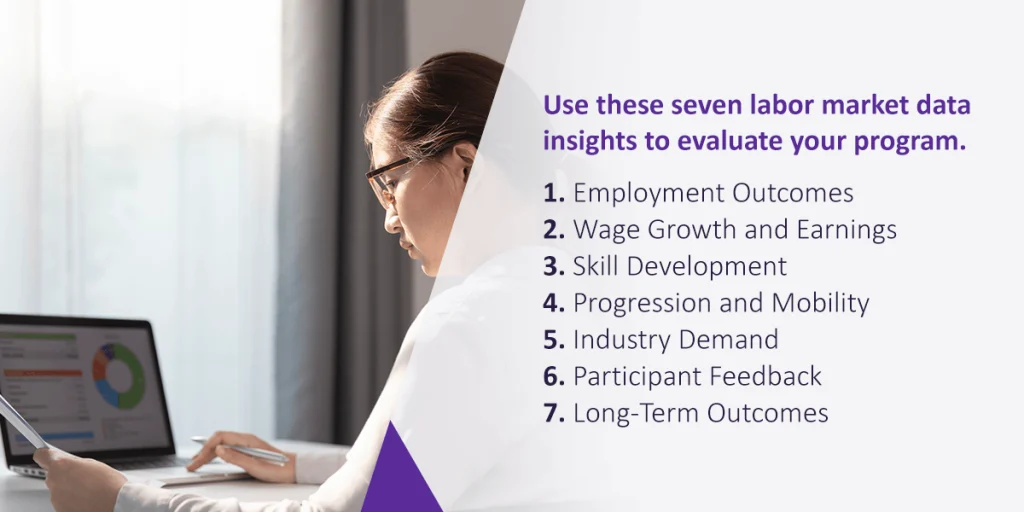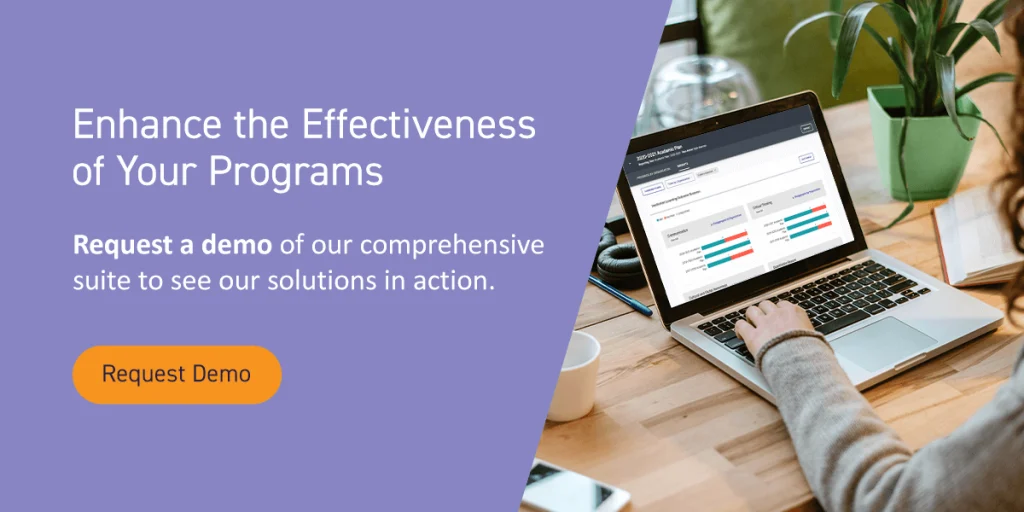
Labor market data represents the current trends in the workforce. This information is ever-changing but can highlight essential elements such as demand for occupations and industries, compensation trends, and workforce demographics. Higher education institutions can use this data to verify trends and strengthen existing programs to better prepare students for employment after graduation. Discover how you can use this data to boost your program effectiveness now.
Measuring program effectiveness with labor market data
Higher education institutions can use labor market data to respond to institutional concerns, such as declining enrollment and low retention rates. Quality labor market data helps institutions ensure they are offering majors and classes that translate into real-world skills. Schools can use labor market data to express the importance of a degree and show students that their education has a direct relation to their careers. Additionally, institutions can use this information to partner with employers to offer work-based learning opportunities such as apprenticeships and internships to enhance student resumes.
Furthermore, labor market data can verify salary ranges for specific occupations, encouraging students to pursue higher education for better upward mobility. By leveraging labor market data and clearly communicating the value of a degree, schools can increase student success, help their institution thrive, and improve retention rates. Institutional stakeholders or an institutional research team can make data-driven decisions and modify each program to enhance effectiveness.
Use these seven labor market data insights to evaluate your program.

1. Employment outcomes
Employment outcomes such as job placement, job retention, and employment rates are excellent factors to consider. Comparing these outcomes to institutional benchmarks can help determine whether a program is effectively facilitating entry into the labor market. Seeing high levels of retention and placement can be encouraging for students looking to find a great return on their educational investment.
Alternatively, a low employment rate or retention could indicate a need for a curriculum change to shift focus to other aspects of the industry. This data could also suggest that many entry-level workers don’t have the necessary skills to succeed, emphasizing a need for a more robust program with meaningful connections to the workforce.
2. Wage growth and earnings
Earnings and wage growth allow students to understand their likely path of upward mobility. Educated workers often experience faster wage growth, and this information can support each student’s goals as they move through their programs, knowing the destination they’re heading toward. Higher education institutions could also show wages before and after program completion to further highlight the importance of a degree. For example, a student participating in an internship likely makes less than a student who has finished their program of study.
Institutions can use this information to show upcoming students the importance of completing their education and how their degrees can directly impact their wages.
3. Skill development
Institutions can evaluate certification rates, the acquisition of new skills, and the attainment of higher-quality jobs with more advanced skill and knowledge requirements to emphasize the importance of completing programs. If your institution is seeing these rates declining from your graduated students, you know it’s time to reevaluate your program for knowledge gaps. Connecting with workers in the industry can help you identify which skills are most important for the field and rework your program to reflect these skills, ensuring each student feels prepared for the tasks within the labor market.
4. Progression and mobility
Career mobility refers to an individual’s ability to move into higher-skilled positions in their industry or field. Data depicting salary increases, promotion rates, innovation, and alumni satisfaction are powerful indicators of program success. Furthermore, industry recognition can depict whether graduates are making strides in the industry, demonstrating the reputation and value of your program. Tracking this information over time can also highlight the lasting long-term outcomes.
You should also consider the networking opportunities within your program. The quality and extent of these experiences can impact a graduate’s ability to access new career opportunities, promotions, and other advancements. Fostering relationships with employers or workers in the industry can help you ensure student success and promote a sense of lifelong learning through valuable connections.
5. Industry demand
Leveraging labor market data provides insight into which sectors are rising in demand and what skills are necessary for success in those industries. Aligning programs with these needs will better prepare your students to enter the workforce with a plethora of skills and knowledge, empowering them to seek unique career paths within their industries. Additionally, monitoring this information can help ensure your program stays relevant so students can gain valuable skills they will use regularly rather than outdated practices.
6. Participant feedback
Some other good indicators you might need to rework your program are surveys and interviews. Connecting with recent graduates and past alums can help you determine if your program is providing the basic foundation and essential skills students need when entering the workforce. Through this data, you can discover whether students are enjoying their careers and if they attribute some of their success to their education. Furthermore, this is one of the best ways to identify specific program weaknesses and strengths to ensure you can boost future student success.
7. Long-term outcomes
Long-term outcomes, including career progression and employment stability, can detail the sustainability of a program. Analyzing long-term labor market value can highlight whether your program supports student needs and prepares them for a lifelong career path. Along with evaluating graduation rates, you can monitor information regarding employment rates, alumni engagement, alumni feedback, and further education enrollment. Take opportunities to invite alums back to campus when possible for opportunities such as guest speaking, mentoring current students, and participation in alumni associations.
Enhance the effectiveness of your programs
Strengthening higher education programs is essential for boosting student success and creating a curriculum that prepares students for a future of growth and mobility. Institutions can enhance their programs by evaluating employment outcomes, wage growth, skill development, mobility, industry demand, participant feedback, and long-term outcomes.
Labor market data can highlight the strengths and weaknesses of a program, and finding the right software to support your needs can enhance your research experience. Institutions can leverage the Market Landscape Data Pack within Watermark Planning & Self-Study to utilize benefits including:
- Incorporating labor market data points into the program review committee process to avoid unnecessary steps in workflow.
- Allowing institutional leaders to monitor and consult trends to inform decisions involving institutional improvement, student success, and organizational strategy.
- Saving time for your institutional effectiveness team when distributing information while feeling confident that stakeholders are referencing the most accurate and relevant data.
Request a demo of our comprehensive suite to see our solutions in action.
















































































































































































































































































































































































































